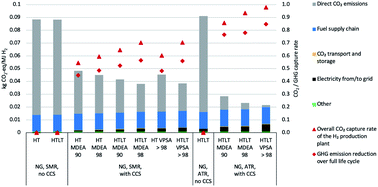Hydrogen production from natural gas and biomethane with carbon capture and storage – A techno-environmental analysis†
Abstract
This study presents an integrated techno-environmental assessment of hydrogen production from natural gas and biomethane, combined with CO2 capture and storage (CCS). We have included steam methane reforming (SMR) and autothermal reforming (ATR) for syngas production. CO2 is captured from the syngas with a novel vacuum pressure swing adsorption (VPSA) process, that combines hydrogen purification and CO2 separation in one cycle. As comparison, we have included cases with conventional amine-based technology. We have extended standard attributional Life Cycle Assessment (LCA) following ISO standards with a detailed carbon balance of the biogas production process (via digestion) and its by-products. The results show that the life-cycle greenhouse gas (GHG) performance of the VPSA and amine-based CO2 capture technologies is very similar as a result of comparable energy consumption. The configuration with the highest plant-wide CO2 capture rate (almost 100% of produced CO2 captured) is autothermal reforming with a two-stage water-gas shift and VPSA CO2 capture – because the latter has an inherently high CO2 capture rate of 98% or more for the investigated syngas. Depending on the configuration, the addition of CCS to natural gas reforming-based hydrogen production reduces its life-cycle Global Warming Potential by 45–85 percent, while the other environmental life-cycle impacts slightly increase. This brings natural gas-based hydrogen on par with renewable electricity-based hydrogen regarding impacts on climate change. When biomethane is used instead of natural gas, our study shows potential for net negative greenhouse gas emissions, i.e. the net removal of CO2 over the life cycle of biowaste-based hydrogen production. In the special case where the biogas digestate is used as agricultural fertiliser, and where a substantial amount of the carbon in the digestate remains in the soil, the biowaste-based hydrogen reaches net-negative life cycle greenhouse gas emissions even without the application of CCS. Addition of CCS to biomethane-based hydrogen production leads to net-negative emissions in all investigated cases.

- This article is part of the themed collections: Energy Frontiers: Hydrogen and SDG13: Climate Action - Technologies to reduce greenhouse gas emissions


 Please wait while we load your content...
Please wait while we load your content...